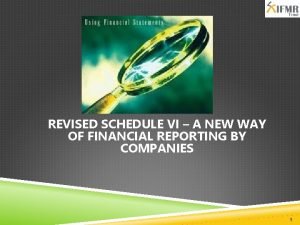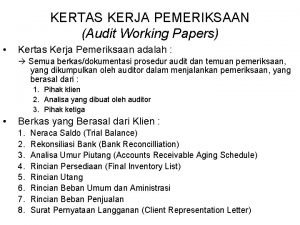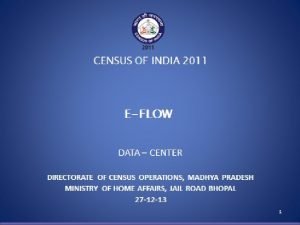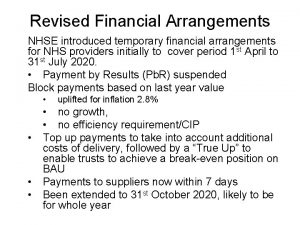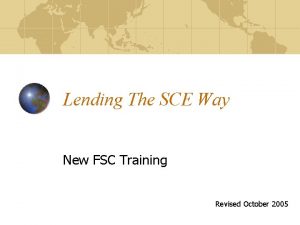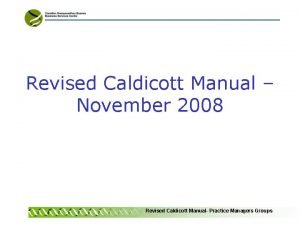REVISED SCHEDULE VI A NEW WAY OF FINANCIAL














- Slides: 14

REVISED SCHEDULE VI – A NEW WAY OF FINANCIAL REPORTING BY COMPANIES 1

FINANCIAL STATEMENTS – COMMON UNDERSTANDING Vs FACTS Common Understanding q Financial statements are complicated and are only meant for bankers, accountants and equity analysts. q Audited Financial statements are entirely accurate and reliable Facts q Financial statements show you where a company’s money came from and where it went q Even the audited financial statements cannot be relied upon; case in point is Satyam scandal 2

FINANCIAL STATEMENTS – COMMON UNDERSTANDING Vs FACTS Common Understanding q Profits = cash q Financial statements are just history Facts: q Profits shown in financial statements may not exactly equate to cash on account of amortisations & other adjustments q Although financial statements are prepared for periods which are completed they do provide clues to the sustainability of any business 3

UNDERSTANDING FINANCIAL STATEMENTS 4

FINANCIAL REPORTING STANDARDS AND SCHEDULE VI q Financial reporting is regulated by Generally Accepted Accounting principles (GAAP) comprising of accounting standards, company law, stock market regulations etc. q Globally, accounting framework is shaped by International Financial Reporting standards (IFRS) q In India, the Accounting Standards (AS) lay down the regulations for various accounting transactions (Date for the Indian Accounting Standards (IAS) is yet to be notified) q The Companies Act, 1956 mandates that all companies except companies for which separate reporting format is prescribed to present their financial statements as per Schedule VI to the Act. 5

NEED FOR REVISION OF REPORTING FORMATS q The various economic and regulatory reforms that have taken place for companies, a need was felt for revision of Schedule VI q The need for harmonising and synchronising the disclosure requirements with international formats so as to achieve convergence of Indian Accounting Standards with IFRS to make Indian companies competitive globally has made the revision inevitable 6

TOTAL Shareholders’ Funds Capital Reserves & Surplus (Dr. balance of P & L A/c) Money Received against share warrants Share Application money Non Current Liabilities Long term borrowings Deferred Tax liability (net) Other long term liabilities Long term provisions Current Liabilities Short term borrowings Trade payables Other short term liabilities Short term provisions TOTAL REVISED SCHEDULE VI Shareholders’ Funds Capital Reserve & Surplus Loan Funds Secured Loan Unsecured Loan EQUITIES AND LIABILITIES OLD SCHEDULE VI SOURCES OF FUNDS KEY REVISIONS – BALANCE SHEET – OLD Vs REVISED – LIABILITIES 7

Non-Current Assets Fixed Assets Tangible Assets Intangible Assets Capital Work in Progress Intangible assets under development Non Current Investments Deferred Tax Asset (Net) Long Term Loans & Advances Other Non-current Assets Current Investments Inventories Trade Receivables Cash and Cash Equivalents Short Term Loans & Advances Other Current Assets TOTAL REVISED SCHEDULE VI Fixed Assets Gross Block Less : Depreciation Net Block Capital Work in Progress Investments Current Assets, Loans and Advances Inventories Sundry Debtors Cash and bank balances Loans and advances Less: Current Liabilities Provisions Net Current Assets Misc. Exp. to the extent not written off Profit and Loss Account TOTAL ASSETS APPLICATION OF FUNDS OLD SCHEDULE VI KEY REVISIONS – BALANCE SHEET – OLD Vs REVISED - ASSETS 8

KEY REVISIONS – BALANCE SHEET GENERAL q Only vertical form of balance sheet allowed with significant changes q q vis-à-vis the structure Concept of presenting schedules to financial statements discontinued. The schedules to the financial statements now called “notes to accounts“ Additional disclosures pertaining about shareholders holding more than 5% of any class of shares and share application money with terms and conditions, expected date of allotment, no. of shares to be issued, amount of premium, etc. Disclosure of all defaults in repayment of loans and interest thereon to be specified in each case Terms of repayment of long term loans to be disclosed …… 9

KEY REVISIONS – BALANCE SHEET GENERAL q Operating cycle forms the basis for classification of assets into current and non-current. This is the time between the acquisition of assets for processing and their realization in cash or cash equivalents. Where the cycle cannot be identified, it is assumed to have a duration of 12 months q Capital Advances specifically required to be presented separately under the head “Loans & Advances” q Separate disclosures for loans and advances received from or given to related parties q Provision for diminution in value of investments to be disclosed separately for current and long term investments 10

KEY REVISIONS – STATEMENT OF PROFIT & LOSS q Name changed to Statement of Profit and Loss q Format prescribed for Statement of Profit and Loss q Any item or expense exceeding one per cent of revenue from operations or Rs. 1. 00 lakh whichever is higher to be disclosed separately q For companies other than finance companies, revenue from operations to be disclosed as three categories, viz. , revenue from sale of products, sale of services and other operating revenues 11


ANY QUESTIONS ? ? 13

THANK YOU 14
 Qprofits
Qprofits The old way and the new way
The old way and the new way Contoh kertas kerja pemeriksaan perusahaan
Contoh kertas kerja pemeriksaan perusahaan Is classwork one word
Is classwork one word 108 mustang way
108 mustang way Frequency trig
Frequency trig Perbedaan one way dan two way anova
Perbedaan one way dan two way anova What is threaded binary tree
What is threaded binary tree Perbedaan anova one way and two way
Perbedaan anova one way and two way Anova hypothesis examples
Anova hypothesis examples One way anova vs two way anova
One way anova vs two way anova Contoh two way anova
Contoh two way anova When i was one i had just begun the day i went to sea
When i was one i had just begun the day i went to sea Talk this way
Talk this way Financial method of motivation
Financial method of motivation
